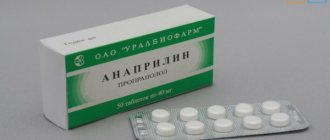The combination antihypertensive drug is Lorista. Instructions for use will show at what pressure and how to correctly take tablets 12.5 mg, 25 mg, 50 mg and 100 mg, H and ND - plus with the diuretic hydrochlorothiazide. What Lorista helps with, information on prices, analogues and patient reviews will also be presented in the article.
Release form and composition
- The drug Lorista is available in the form of coated tablets, 50 mg and 100 mg, 30 and 60 tablets per package.
- Lorista N tablets contain the drug Lorista itself 50 mg plus a diuretic substance - hydrochlorothiazide 12.5 mg.
- Lorista ND (additionally contains 25 mg hydrochlorothiazide).
The tablet contains the active substance - losartan (INN - Losartanum) in a volume of 50 mg or 100 mg.
Excipients: cellactose, starch, cellulose, silicon dioxide, magnesium stearate.
Categories
AllergistAnesthesiologist-resuscitatorVenereologistGastroenterologistHematologistGeneticGynecologistHomeopathDermatologistPediatric gynecologistPediatric neurologistPediatric urologistPediatric surgeonPediatric endocrinologistNutrologistImmunologistInfectious disease specialistCardiologistCosmetologistSpeech therapistElorologistMammologistMedical lawyerNarcologistNeurologistNeurosurgeon NephrologistOncologistOncourologistOrthopedist-traumatologistOphthalmologistPediatricianPlastic surgeonProctologistPsychiatristPsychologistPulmonologistRheumatologistRadiologistSexologist-AndrologistDentistTherapistUrologistPharmacistPhytotherapistPhlebologistSurgeonEndocrinologist
Pharmacological characteristics
The drug has a reverse effect on angiotensin receptors, which leads to a decrease in blood pressure and a pronounced diuretic effect.
The maximum concentration is reached 1 hour after ingestion, then Lorista binds to plasma proteins and is distributed throughout the body in accordance with the blood flow. Penetration through the protective barrier of the brain is insignificant.
Neutralization of Lorist occurs in the liver with the formation of active and inactive breakdown products. The drug is excreted in urine and bile.
Contraindications
According to the instructions, Lorista should not be prescribed for the following diseases:
- Hyperkalemia;
- The patient is lactose intolerant;
- Syndrome of impaired absorption of galactose and glucose;
- Low blood pressure.
Pregnant women and nursing mothers, as well as children under the age of 18 should refrain from taking the drug. Lorista is not prescribed for liver or kidney dysfunction in patients with anuria (a disease in which there is no urine in the bladder).
Experts advise taking the drug with caution to people with water-electrolyte imbalances, as well as with a reduced volume of circulating blood.
Why is Lorist prescribed?
At what pressure should it be taken? Indications for taking the medicine are:
- Arterial hypertension;
- Arterial hypertension and left ventricular hypertrophy (to reduce the risk of morbidity and mortality);
- Chronic heart failure (as a drug included in combination therapy);
- Diabetic nephropathy occurring against the background of proteinuria and hypercreatininemia in patients with type II diabetes mellitus.
Features of application
During treatment with Lorista (tablets), the instructions for use allow you to additionally take other antihypertensive drugs. For older people, no special selection of the initial dosage is required.
The actions of the drug may lead to an increase in the concentration of creatinine and urea in the blood serum of patients who have bilateral renal artery stenosis or stenosis of the artery of one kidney.
Under the influence of hydrochlorothiazide, arterial hypotension increases, electrolyte balance is disturbed, which is characterized by a decrease in circulating blood volume, hyponatremia, hypochloremic alkalosis, hypomagnesemia, hypokalemia. The effect of a diuretic is aimed at increasing the concentration of cholesterol and triglycerides, changing the body’s tolerance to glucose molecules, reducing the excretion of calcium ions in the urine, which leads to their increase in the blood serum. Hydrochlorothiazide can cause hyperuricemia and gout.
The combination drug contains milk sugar, which is contraindicated in patients suffering from a deficiency of the lactase enzyme, galactosemia or glucose-galactose intolerance syndrome.
At the initial stages of treatment with an antihypertensive drug, a decrease in blood pressure and attacks of dizziness are possible, which disrupts the psychophysical activity of the body
Therefore, patients whose work requires increased attention when driving vehicles or complex mechanisms must determine their condition before starting to perform their duties.
Instructions for use
Lorista is taken orally, regardless of food intake, the frequency of administration is 1 time per day.
For arterial hypertension, the average daily dose is 50 mg. The maximum antihypertensive effect is achieved within 3-6 weeks of therapy. It is possible to achieve a more pronounced effect by increasing the dose of the drug to 100 mg per day in two doses or in one dose.
When taking diuretics in high doses, it is recommended to start Lorista therapy with 25 mg per day in one dose.
Elderly patients and patients with impaired renal function (including patients on hemodialysis) do not require adjustment of the initial dose of the drug.
In patients with impaired liver function, the drug should be prescribed at a lower dose.
For chronic heart failure, the initial dose of the drug is 12.5 mg per day in one dose. In order to achieve the usual maintenance dose of 50 mg per day, the dose must be increased gradually at intervals of 1 week (eg, 12.5 mg, 25 mg, 50 mg per day). Lorista is usually prescribed in combination with diuretics and cardiac glycosides.
To reduce the risk of stroke in patients with arterial hypertension and left ventricular hypertrophy, the standard starting dose is 50 mg per day. In the future, hydrochlorothiazide may be added in low doses and/or the dose of Lorista may be increased to 100 mg per day.
For kidney protection in patients with type 2 diabetes mellitus with proteinuria, the standard starting dose of Lorista is 50 mg per day. The dose of the drug can be increased to 100 mg per day, taking into account the reduction in blood pressure.
Side effect
Classification of the frequency of side effects (WHO): very often (≥1/10), often (from ≥1/100 to
From the hematopoietic system: uncommon - anemia, Henoch-Schönlein purpura, ecchymosis, hemolysis, agranulocytosis, aplastic anemia, hemolytic anemia, leukopenia, thrombocytopenia.
From the senses: infrequently - blurred vision, burning sensation in the eyes, conjunctivitis.
From the skin: often - alopecia, dry skin, erythema, photosensitivity, increased sweating; infrequently - urticaria, skin itching.
Other: often - asthenia, weakness, peripheral edema; infrequently - anorexia, exacerbation of gout.
From the laboratory parameters: often - hyperkalemia, a slight decrease in the concentration of hemoglobin and hematocrit; infrequently - moderate increase in the concentration of urea and creatinine in the blood plasma, hyperglycemia, hyperuricemia, disturbances in water and electrolyte balance; rarely - increased ALT activity; very rarely - increased AST activity and bilirubin concentration.
Side effects
Side effects of Lorista tablets reviews and clinical studies include:
- General disorders: asthenia, edema, weakness, rash.
- From the respiratory system: sinusitis, runny nose, cough, upper respiratory tract infection, pharyngitis.
- From the heart: angina pectoris, palpitation, tachycardia.
- From the digestive tract: dyspepsia, abdominal pain, persistent constipation.
- From the nervous system: vertigo, drowsiness, insomnia, headache, muscle cramps.
- From the vascular system: symptomatic arterial hypotension, orthostatic dose-dependent effect.
- Laboratory indicators: increased ALT levels, hyperkalemia.
Drug interactions and special instructions
In the review of Lorista, it is necessary to mention drug interactions. Firstly, it must be taken into account that other hypotonic drugs can enhance the antihypertensive effect of sartan. We recommend that you read the article about the drug Cocarnit.
The simultaneous use of Lorista with potassium-sparing diuretics (Spironolactone, Eplerenone, Amiloride) may lead to an increase in the potassium content in the blood serum. Losartan can also reduce the excretion of lithium, so it should be combined with lithium preparations with caution.
Special instructions:
- Patients with a history of angioedema should be closely monitored by physicians when consuming Lorista.
- In patients with reduced blood volume, symptomatic arterial hypotension may develop.
- When treating patients who have problems with the liver or kidneys, dosage adjustment is recommended.
- Lorist tablets should not be combined with alcoholic beverages.
- During treatment, it is highly not recommended to take potassium-sparing diuretics, potassium supplements, or potassium-containing salt substitutes.
- Sartan should be taken with caution by people who have been diagnosed with aortic or mitral stenosis, or hypertrophic obstructive cardiomyopathy.
Use during pregnancy and lactation
There are no data on the use of Lorist during pregnancy. Fetal renal perfusion, which depends on the development of the renin-angiotensin system, begins to function in the 3rd trimester of pregnancy. The risk to the fetus increases when taking the medication in the 2nd and 3rd trimesters. If pregnancy is established, therapy with Losartan should be discontinued immediately.
There is no data on the excretion of Losartan in breast milk. Therefore, the issue of stopping breastfeeding or discontinuing therapy should be decided, taking into account its importance for the mother.
How the drug works
The instructions for a combined antihypertensive drug (the drug "Lorista") describe the pharmacological action of each active component.
One of the active ingredients is losartan, which acts as a selective antagonist of the enzyme angiotensin type 2 on non-protein receptors.
Test tube and animal studies have established that the action of losartan and its carboxyl metabolite is aimed at blocking the effects of angiotensin on angiotensin type 1 receptors. This activates renin in the blood plasma and causes a decrease in the concentration of aldosterone in the blood serum.
By causing an increase in the content of type 2 angiotensin, losartan activates the receptors of this enzyme, but at the same time does not change the functioning of the type 2 kininase enzyme involved in the metabolism of bradykinin.
The action of the active component of the drug "Lorista" is aimed at reducing the total peripheral resistance of the vascular bed, pressure in the vessels of the pulmonary circulation, afterload, and providing a diuretic effect.
Losartan prevents the development of pathological enlargement of the heart muscle and increases the resistance to physical work of the human body who has chronic heart failure.
Daily use of one dose of losartan causes a sustained decrease in upper (systolic) and lower (diastolic) blood pressure. Throughout the day, under the influence of this substance, blood pressure is uniformly controlled, and the antihypertensive effect coincides with the natural circadian rhythm. The decrease in pressure at the end of the losartan dosage occurs by 80% compared to the peak activity of the active component. When treated with the drug, there is no effect on the heart rate, and when you stop taking it, signs of drug withdrawal do not develop. The effectiveness of losartan applies to male and female bodies of all ages.
As part of combined drugs, the effect of hydrochlorothiazide as a thiazide diuretic is associated with impaired absorption of chlorine, sodium, magnesium, potassium and water ions found in primary urine back into the blood plasma of the distal nephron of the kidneys. The substance enhances the retention of calcium ion and uric acid. Hydrochlorothiazide exhibits antihypertensive properties due to the dilation of arterioles. The diuretic effect begins after 60-120 minutes, and the maximum diuretic effect lasts from 6 to 12 hours. The optimal antihypertensive effect from treatment with the drug occurs after 1 month.
Analogs
- Blocktran;
- Brozaar;
- Vasotens;
- Vero Losartan;
- Zisakar;
- Cardomin Sanovel;
- Carzartan;
- Kozaar;
- Lakea;
- Lozap;
- Losarel;
- Losartan;
- Losartan potassium;
- Losakor;
- Lotor;
- Presartan;
- Renicard.
When choosing analogues, it is important to understand that the instructions for use of Lorist N, the price and reviews do not apply to drugs with similar effects. It is important to consult a doctor and not change the drug yourself.
Lorista analogues and generics
“Lorista,” as the instructions for use say, is itself an analogue of “Kozaara,” but with good reviews and an affordable price. The original “Kozaar” is a product, and “Lorista” is produced in Slovenia, by the famous company KRKA.
Currently, the following analogues of Lorista can also be purchased in the Russian Federation:
- “Presartan” - India, “Ipka” - from 131 rubles.
- "Losartan Canon" - produced by the domestic JSC "Canonpharma Production" - from 100 rubles;
- “Vasotens” Icelandic, from 140 rubles;
- "Bloktran", RF, "Pharmstandard", from 145 rubles. per package 50 mg No. 30;
- “Lozarel” produced by “Lek”, Slovenia, from 177 rubles.
An analogue of Lorista-N is also presented on the market. This is, for example, “Lozap plus”.
Currently, there is a wide choice of drugs to reliably prolong the life of a patient suffering from heart failure and hypertension, against the background of increased cardiac risk. The most important thing is that treatment is not limited to taking drugs in advanced stages, but is largely preventative and prevents the development of high coronary risk.
Tags:
heart pressure
What do the reviews say?
On the medical forum, patients' opinions about the effectiveness differ - there are positive and negative reviews from patients. There are allegations that the pills do not normalize blood pressure for everyone; the drug can cause side effects such as coughing or allergic reactions such as urticaria. Some patients say that only these pills helped lower their blood pressure.
Reviews from doctors about Lorista: each patient needs an individual selection of the drug and dose, taking into account the characteristics of the body and the course of hypertension, which will allow achieving the optimal effect.
Side effects
Some patients may experience undesirable effects from treatment with this antihypertensive drug.
When using the drug "Lorista" (tablets), the instructions for use include a list of side effects associated with various body systems. The effect on the central nervous system is manifested by headache, systemic and non-systemic dizziness, insomnia, fatigue, migraine.
When affecting the cardiovascular system, the drug causes orthostatic dose-dependent hypotension, palpitations, tachycardia, and vascular inflammation.
The effect on the respiratory system is manifested by cough, infection in the upper respiratory tract, pharyngitis, swelling of the nasopharyngeal mucosa.
The digestive system malfunctions in the form of diarrhea, dyspepsia, nausea, vomiting, abdominal pain, hepatitis, liver dysfunction when the activity of liver enzymes and bilirubin is changed.
The effect on the musculoskeletal system is manifested by myalgia, back pain, and arthralgia.
The effect on the hematopoietic organs is manifested by anemia and purpura.
Laboratory parameters also change, characterized by hyperkalemia, increased levels of hemoglobin, creatinine, hematocrit, and urea in the blood plasma.
The action may be accompanied by allergic reactions, manifested by urticaria, itching, anaphylactic shock, angioedema of the face, neck, upper torso and peripheral organs.
Reviews about Lorist N
The average rating for the drug is 4.5 points (out of 5). Buyers note the effectiveness of the drug and its mild effect. Disadvantages include the need to take it every day and side effects.
https://www.youtube.com/watch?v=https:accounts.google.comServiceLogin
Positive reviews from doctors about the drug indicate its high effectiveness. However, experts note that it must be taken strictly in doses determined by the doctor in order to reduce the risk of side effects.
Reviews of Lorista ND coincide with reviews of Lorista N.
Nadezhda Maslova
A good drug, few contraindications and well tolerated.
Natasha Knyazeva
I started taking this drug. Dose 12.5 once daily. The pressure does not decrease. In the morning it was 152/70. By evening it rose to 167/65. I don't like it yet.
Natalie
I was first prescribed veroshpiron for 2 days, 2 tablets, 2 times a day, then Larista, 1 tablet. in the morning, it stays at 120-70, I switched to half, I worked like that for 67 years... never treated, my blood pressure has been jumping since I was 50. Thank God I’m fine now, the only thing is a cough.
Natalya! Cough is primarily a side effect of the lasortans included in Lorista. So, as soon as possible, consult a doctor with a request to replace lasortan with other gr. medications...most likely an ACE inhibitor
Alisa Ivanova
Natalya, cough as a side effect is more typical for ACE inhibitors (bradykinin mechanism of occurrence), and not for sartans.
Khaperskaya Olga
Can I take it if I have diabetes?
Galina Sitnikova (Bragina)
Can this medicine be used for diabetes? 2
https://www.youtube.com/watch?v=ytpolicyandsafetyru
Nada White Raven
Tatiana Kalchenko
Is it possible to drink coffee while using Lorista N?
jhgkjf jklgjklg
Ivan Pavlov
Until I wake up alive!!!
Nada White Raven
this is for babies. And for a woman over 50 years old 18090 is normal
Valentina Afanasyeva (Sipetaya)
Irina Zimina
VALENTINE
I was prescribed Lorista N, I took it for a week and there was no effect, should I continue taking it?
Galina Dmitrieva
I take porista 50 mg concor 2.5 in the morning and 50 mg glorista in the evening, but A/D crises occur at 180/80 in the evening.
Marina Grezneva
Is it possible to use Lorista N and asparkam at the same time?
Lidia Telnova
I’m already 180, barely alive, I’m 59 years old, and you speak like a baby. That means you just don’t feel like a strong person. The medications need to be changed or some other medication needs to be added to it. I take Larista 12.5 plus Telzap 40 mg and at night 40 mg Telzap and 5 mg amlodipine. No, look how many contraindications and side effects Larista has, my liver has worsened, bitterness in my mouth and causes a runny nose. I want to replace it. I will choose something else. Be healthy. Change medications, change doses.
Nata Galushko
My therapist prescribed Lorista for me, I’ve had hypertension for a long time... it doesn’t make you cough - and it keeps my blood pressure stable
Galina Fronya-Nenasheva
After an illness, my blood pressure does not decrease. 160-90 and 170-95. I take enalapril. Concor. They suggest starting to take LORISTA.. Tell me what to do?
PIKHANIDA KONDLUNAINEN
Andrey Yakovlev
Lozap, Lorista, Gizaar, Kozaar, this is all Losartan. The name changes depending on the manufacturer and the price of course.
Indications for use
- hypertension (high blood pressure) in various forms and in children from 6 years of age;
- kidney pathologies caused by hypertension and complications of diabetes mellitus;
- chronic heart failure in patients over 60 years of age;
- ineffectiveness of ACE inhibitor drugs;
- prevention of stroke in patients with hypertension;
- prevention of progression of cardiac hypertrophy.
- allergy;
- planning to conceive a child;
- pregnancy;
- breastfeeding a child. Lorista is not used to treat women who are breastfeeding;
- severe diseases affecting the kidneys and liver;
- childhood. Lorista is not used to treat children under 6 years of age.
- congestive form of heart failure;
- synthesis of increased amounts of Aldosterone in the body;
- tendency to severe angioedema;
- severe stenosis (narrowing) in the renal vessels (arteries). Prescribing Lorista can lead to severe hypotension and complications.
DETAILS: Moderate sinus arrhythmia in a child aged 4 to 8 years, symptoms and treatment
Pharmacological activity
The components of Lorista N 100 (similar to other doses - Lorista N 50 mg, Lorista 25 mg) act on lowering blood pressure more significantly than each substance individually. This effect is attributed to their complementary actions.
Hydrochlorothiazide, due to its diuretic effect, increases renal plasma activity, increases aldosterone production, reduces potassium, and increases angiotensin II.
Losartan, present in Lorista N, blocks the effects of angiotensin II, inhibition of aldosterone reduces potassium excretion induced by diuretic therapy.
Lorista N causes a decrease in hyperuricemia induced by diuretic treatment.
The time after which Lorista 50 (100, 25) begins to act is 15–30 minutes, the antihypertensive effect is present for 24 hours. Although a significant decrease in blood pressure has been reported, the drug does not have a significant effect on heart rhythm. Studies have shown that after 12 weeks of therapy, lower blood pressure decreased by approximately 13.2 mmHg. Art.
The effect of the drug on the body
Lorista is a synthetic drug. Belongs to the pharmacological class of angiotensin type II receptor antagonists.
Has pronounced hypotensive properties. Has a beneficial effect on the condition of the heart muscle. Angiotensin two is a powerful vasoconstrictor, a determining factor in the pathophysiology of hypertension.
It binds to AT1 receptors located in the smooth muscles of the kidneys, blood vessels, heart, and adrenal glands, and causes constriction of arterioles, release of aldosterone and other biological actions aimed at increasing blood pressure.
Losartan potassium selectively blocks AT1 receptors, preventing all significant effects of angiotensin two. The active substance does not have an agonistic effect and does not affect the hormones that are responsible for regulating the functioning of the cardiac system.
Taking losartan potassium leads to an increase in serum renin and angiotensin two. Despite this, antihypertensive activity is maintained. This confirms the effectiveness of angiotensin two receptor blockade.
The maximum hypotensive effect develops a couple of hours after taking the tablet . Stabilization of blood pressure levels is observed after several weeks of regular use of the drug.
In people with CHF, treatment with Lorista leads to a decrease in swelling, stress on the myocardium, and a decrease in the likelihood of complications of the disease in the form of a heart attack or stroke.
Cheap analogues of Lorista
The KRKA company enjoys the respect of consumers because the drugs it produces meet clinical requirements. At the same time, their quality is proven by studies of bioequivalence to the original Losartan - Cozaar. However, there are other drugs containing Losartan. Lorista's analogues and substitutes may be cheaper. Examples include Vasotens, Blocktran, and Presartan.
The cheapest analogue is “Bloktran”, which is inferior in the complexity of the dosage form, but has similar effectiveness as “Lorista”. Vazotens is slightly more expensive than Bloktran, although it is almost identical in effectiveness. The selection criterion in this case is affordability. At the same time, the drug "Bloktran" has indications identical to those of any analogues containing "Losartan". This is natural.
The principle of action of the drug
The product is available in the form of film-coated tablets. The surface is painted light yellow. The tablets are oval in shape, slightly convex. There is a chamfer on one of the sides.
The therapeutic effect is achieved due to the presence of the active substance losartan potassium. Each tablet contains this element in the amount of 12.5, 25, 50 or 100 mg.
Lorista tablets
Additionally, the central part contains microcrystalline cellulose, magnesium stearate, anhydrous colloidal silicon dioxide, pregelatinized starch, cellactose. The film shell contains dye E104, titanium dioxide, talc, hypromellose, propylene glycol.
Losartan potassium blocks all hemodynamic and proliferative effects of angiotensin type II. The active substance selectively binds to AT1 receptors. It does not affect the activity of other receptors and does not disrupt the production of hormones involved in regulating the functioning of the cardiovascular system.
The main component does not suppress the activity of the kininase two enzyme, on which the production of bradykinin, which expands the arterial lumen and reduces pressure in the bloodstream, depends.
Regular use of tablets leads to the following results:
- the total peripheral vascular resistance decreases;
- afterload on the myocardium decreases;
- excess fluid is removed from the body;
- pressure in the pulmonary circulation is normalized;
- tolerance to physical activity increases in patients with chronic heart failure.
Lorista prevents hypertrophic changes in the myocardium. The medication affects systolic and diastolic blood pressure. The effect of the medicine lasts for 24 hours after administration. The maximum hypotensive effect is observed 5-6 hours after taking the tablet.
The cost of Lorist varies from 140 to 650 rubles per package. Much depends on the concentration of the active substance and the pricing policy of the distributor. So, for 30 tablets with a dosage of 12.5 mg you will have to pay 145 rubles, for 25 mg - 190 rubles. A package of Lorista of 30 pieces with a potassium losartan concentration of 50 mg costs 200 rubles. The price of 100 mg tablets is 230 rubles for 30 pieces and 650 rubles for 90.
Lorista does not cause withdrawal symptoms and does not affect heart rate. The drug is equally effective in treating young and elderly people.
Compound
The drug “Lorista” is a drug with a diuretic effect. Its main therapeutic effect is due to the active substance – losartan. Excipients are also used in the production of tablets. The product contains pregelatinized starch, cellactose, and corn starch. The tablets do not lack magnesium stearate and silicon dioxide. Microcrystalline cellulose, a constant component of almost all medications, is also present in “Lorist”.
The main component of the drug, losartan, blocks angiotensin receptors. The drug has a similar effect on some other systems of the body: on the vessels of the kidneys, the adrenal cortex.
“Lorista”, for blood pressure, is a drug that helps to increase the lumens in the arteries, which leads to a decrease in blood pressure. Two types of medicine are offered for free sale: “Lorista ND” and “Lorista N”. Being a combination type of medicine, these drugs exert their therapeutic effect due to the interaction of two main components - losartan and hydrochlorothiazide. The second element has pronounced diuretic properties.
Pharmacodynamics and pharmacokinetics
Both drugs (Lorista N and Lorista ND) are a combination drug that has an antihypertensive effect.
Losartan leads to an increase in renin activity and also reduces the plasma concentration of aldosterone. Reduces peripheral vascular resistance, the level of pressure in the pulmonary circulation, has a diuretic effect, and reduces afterload.
Losartan prevents the occurrence of myocardial hypertrophy and increases exercise tolerance in those patients who suffer from heart failure. Taking losartan helps lower blood pressure. Does not cause withdrawal syndrome, does not affect pulse rate.
Effective in people of any gender, as well as in older people (over 65 years old).
Hydrochlorothiazide has an antihypertensive effect due to arteriolar dilation. The effect after administration is achieved after 1-2 hours, the maximum is observed after 4 hours, lasts up to 12 hours. The hypotensive effect is achieved after administration after 3-4 days, but to achieve the optimal effect it takes up to 4 weeks.
When used separately, the pharmacokinetics of hydrochlorothiazide and losartan differ from those when used simultaneously.
Losartan is absorbed from the gastrointestinal tract. Serum concentration does not depend on the drug taken simultaneously with food. Bioavailability is at 33%. The maximum concentration is observed after 60 minutes. About 35% of the drug is excreted through the kidneys, 58% with bile.
The absorption of hydrochlorothiade after oral administration is about 60-80%. The maximum concentration is achieved from 1 hour to 5 hours. It is quickly eliminated through the kidneys as it is not metabolized.
How the drug works
The instructions for a combined antihypertensive drug (the drug "Lorista") describe the pharmacological action of each active component.
One of the active ingredients is losartan, which acts as a selective antagonist of the enzyme angiotensin type 2 on non-protein receptors.
Test tube and animal studies have established that the action of losartan and its carboxyl metabolite is aimed at blocking the effects of angiotensin on angiotensin type 1 receptors. This activates renin in the blood plasma and causes a decrease in the concentration of aldosterone in the blood serum.
By causing an increase in the content of type 2 angiotensin, losartan activates the receptors of this enzyme, but at the same time does not change the functioning of the type 2 kininase enzyme involved in the metabolism of bradykinin.
The action of the active component of the drug "Lorista" is aimed at reducing the total peripheral resistance of the vascular bed, pressure in the vessels of the pulmonary circulation, afterload, and providing a diuretic effect.
Losartan prevents the development of pathological enlargement of the heart muscle and increases the resistance to physical work of the human body who has chronic heart failure.
Daily use of one dose of losartan causes a sustained decrease in upper (systolic) and lower (diastolic) blood pressure. Throughout the day, under the influence of this substance, blood pressure is uniformly controlled, and the antihypertensive effect coincides with the natural circadian rhythm. The decrease in pressure at the end of the losartan dosage occurs by 80% compared to the peak activity of the active component. When treated with the drug, there is no effect on the heart rate, and when you stop taking it, signs of drug withdrawal do not develop. The effectiveness of losartan applies to male and female bodies of all ages.
As part of combined drugs, the effect of hydrochlorothiazide as a thiazide diuretic is associated with impaired absorption of chlorine, sodium, magnesium, potassium and water ions found in primary urine back into the blood plasma of the distal nephron of the kidneys. The substance enhances the retention of calcium ion and uric acid. Hydrochlorothiazide exhibits antihypertensive properties due to the dilation of arterioles. The diuretic effect begins after 60-120 minutes, and the maximum diuretic effect lasts from 6 to 12 hours. The optimal antihypertensive effect from treatment with the drug occurs after 1 month.
Reviews
The drug "Lorista" receives varied reviews. Some patients note an improvement in their condition in the initial stages of treatment, when a decrease in blood pressure was observed. Others note an increase in blood pressure in the evening or a surge in emotionality. In this case, it is necessary to cancel treatment with Lorista (tablets). The instructions combine patient reviews in the “Side Effects” section, which lists all possible adverse events that were recorded when using this antihypertensive drug.
The drug "Lorista" is taken every day, using a minimum dosage, which is increased over time due to the body becoming accustomed to the active substance. The effect of treatment does not appear immediately, but as the medication accumulates in the body.
Contraindications Lorista
Children and adolescents are strongly advised not to take Lorista due to a lack of relevant research.
Overdose
- If the patient is allergic to Lisartan, hydrochlorothiazide, or any other ingredient in this medicine. The patient's sensitivity and how the allergy manifests itself should be reported: detection of rashes, blisters, itchy skin, shortness of breath, wheezing, cough, swollen face, lips, tongue, throat, or any other symptoms.
- If the patient is more than 12 weeks pregnant.
conclusions
In order to summarize the above, we consider it necessary to note several particularly important aspects:
- Firstly, these drugs differ in their compositions. So, for example, in the case of Lorista N, a component such as hydrochlorothiazide is provided. In principle, its presence adds an advantage to this drug because it reduces Na+ reabsorption.
- The price of these two drugs is also different. So, if for a standard “Lorista” you will have to pay 130 rubles, then to purchase “Lorista N” you will have to pay 230 rubles.
Medicine and healthComment
You can buy Natural remedies for hypertension here
Buy at a discount
Promo code for discount MAT6375
Natalia Kurbanova
I really like the drug Lorista, but I had an allergic reaction to it, in the form of hives on my neck and arms. What should I do? Cancel or will it pass?
Victor Oproshchenko
I have an exacerbation of gout after taking it. Should I stop taking it?
Prince Vladimir
I apologize: Lorista N! Although it's the same thing!
Rufina Krinova
Even though I’m a grandmother and an adult—77—my blood pressure also began to skyrocket. The son ordered to forget about Lorist forever! I'm switching back to Ko-Renitek. Health to you!
Valentina Karpukhina
Yesterday my therapist changed Diroton to Lorista, explaining this blood pressure, as well as the flashing of the “northern lights” in my peripheral vision...... can someone answer that Diroton is not a similar medicine... should I drink or not drink Lorista?
Valentina Karpukhina
and here's the question? We write and no one answers us, then why write? to whom and to whom do we ask ourselves?
Olya Kolotovkina
strong reduces 90 60 d
https://www.youtube.com/watch?v=ytaboutru
I drank Lorista50, numbness in my hands started, I was diagnosed with carpal tunnel syndrome, I stopped drinking Lorista, the numbness went away like this.
Elena Koltsova
Elena Koltsova
I take Sotahexal and Lorista in the morning, and Sotahexal in the evening. After taking Lorista, the blood pressure drops to 90/60 or less. I take 1/4 tablet/25 mg. The doctor doesn’t believe me.
Fandera Z
My blood pressure rises mainly at night. The instructions for Lorista do not indicate whether the drug can be taken at night. And how long can you take it? Maybe someone knows?
Galina Dmitrieva
I've been drinking Porista for 1 year, helping with Lorista 50 Concor 2.5 once in the morning
Natalia Ogurtsova
Blood pressure dropped very significantly: 90/68
Denis Jalilov
Galina Dmitrieva
Galina, that’s right, I’ve been drinking for two weeks, in the third week the pressure can be said to be normal, it became an average of 130/90 and it was 170-160/105-100
I've been drinking it for three years now and I'm very pleased.
Nadezhda Nadezhda
Denis Rudnev
How to take it if blood pressure is normal in the morning and rises in the evening?
According to reviews, Lorista N is an effective combined remedy for normalizing blood pressure and reducing swelling. Patients emphasize the mild effect of the drug, its rapid therapeutic effect, the possibility of simultaneous use with other drugs, ease of use, and long shelf life.
As a disadvantage, some indicate the need for long-term daily use of Lorista N in the morning.
Mechanism of action of Lorist
Lorista, photo of the drug
Losartan copes with the problem in a different way, but also effectively. It does not block the enzyme, but acts “simply and brilliantly”: it neutralizes specific receptors in organs for angiotensin, which trigger the vasopressor cascade.
These receptors are found in the brain, adrenal glands, liver and kidneys. It is these organs that are responsible for the uninterrupted operation of the RAAS, and if a pathological response does not develop in them and in the vessels, leading to an increase in pressure, then the problem is considered solved.
That is why sartans, to which losartan (Lorista) belongs, are called in medical parlance “angiotensin receptor antagonists,” or more simply, “angiotensin antagonists.”
Reviews from doctors about Lorist, as well as from researchers, are quite favorable. This is a high-quality generic “Cozaara” (this is the name of the first and original losartan, a representative of the first generation of sartans), and in the body the drug does the following:
By dilating blood vessels, it reduces the load on the heart (reduces preload), and this is very important for weakness of the heart muscle; Reduces pressure not only in small arteries and arterioles, but also in the aorta; Reduces pressure in the blood vessels of the lungs, that is, reduces pulmonary hypertension; Since losartan reduces aldosterone synthesis, its control over sodium and water retention is weakened. As a result, the diuretic effect of Lorista also reduces the volume of circulating fluid
And this facilitates the work of the heart and reduces the amount of edema; As a result of long-term use, a “comfort zone” is formed for the myocardium: its work decreases, the load on the heart decreases, and the volume of fluid decreases. All this prevents the progression of myocardial hypertrophy.
Cardiologists and physicians were very pleased when they tested losartan and included it in all treatment regimens.
Overdose
If you suspect an overdose, consult a doctor immediately. Signs of a serious life reaction include wheezing, chest tightness, fever, itching, severe cough, skin discoloration, seizures, swelling of the face, lips, tongue, or throat.
- Signs of low potassium.
- Severe dizziness or loss of consciousness.
- Strong headache.
- Rash.
- If the patient becomes pregnant while taking this medication.
- There is no improvement or worsening of the condition.
Terms of sale and storage
You can purchase the medicine "Lorista" in pharmacy chains with a doctor's prescription. The pharmaceutical product must be kept away from small children and in a room where the temperature does not exceed 30 degrees Celsius. If the described medication is stored correctly, its shelf life reaches 5 years.
You can purchase a diuretic antihypertensive pharmaceutical drug at a pharmacy, but you will need a prescription from a doctor. The tablets should be placed out of the reach of children, where the temperature does not exceed 25 degrees Celsius. If stored properly, the shelf life of Lorista will be 5 years. It is extremely important not to use the medication after the specified period.
Analogues of the drug
“Losartan” and “Lorista” are interchangeable medications because they are similar in composition. Names of foreign and domestic analogues:
- "Angizar";
- "Hyperzar";
- "Xartan";
- "Lozap";
- "Pulsar";
- "Kandekor";
- "Hizart."
Trade names of losartan and hypothiazide combination tablets:
- "Angisar Plus";
- "Co-Centor";
- "Sartokad-N";
- "Gizaar Forte";
- "Firmasta".
Among doctors and patients, the medicine is known under the trade name “Cozaar”, produced by the English pharmaceutical company. The quality of generics is good, but domestic drugs are cheaper. In case of intolerance to losartan, biphenyl tetrazole derivatives are prescribed, among which the most studied is Valsartan.
Patient reviews
Azat, 54 years old, Ufa: “I’ve been taking Lorista in the morning for a month now. The therapeutic effect lasts all day. And even the next morning before taking the pill, the pressure is still within acceptable limits.”
Marina, 50 years old, Kazan: “I think the great advantage of Lorista N is that the hydrochlorothiazide it contains, while relieving swelling well, does not increase the frequency of urination.”
Vladislav, 60 years old, St. Petersburg: “I took Lorista for several years, but over time I began to notice that by the evening the pressure was already exceeding the norm. The doctor recommended changing the drug."
Signs of overdose
When taking a large dose of the drug, it is important to monitor the patient's pulse.
If the maximum permissible daily dose is exceeded, bradycardia or tachycardia develops and blood pressure drops. The priority measure in the treatment of overdose is to stabilize the functioning of the cardiovascular system. Tube gastric lavage and the use of enterosorbents are recommended. Monitoring pulse, blood pressure and urination is mandatory. Hemodialysis is ineffective.
Features of therapy
Taking the drug Lorista has its own characteristics that need to be known and taken into account to achieve the maximum therapeutic effect.
It is important to adhere to the recommendations of the tablet manufacturer and doctor’s instructions in treatment. The doctor has the right to make some changes to the treatment regimen proposed by the manufacturer of the medication.
This is explained by the fact that each person’s body is individual. It is important to consider the compatibility of Lorist with other products. For example, rifampicin and fluconazole reduce the concentration of potassium in the blood of losartan, which means they make the drug less effective.
In combination with potassium-sparing diuretics, angiotensin two blockers, and potassium salts, hyperkalemia may develop. It is not recommended to take Lorista together with lithium medications . Nonsteroidal anti-inflammatory drugs reduce the severity of the hypotensive effect.
The combination of Lorist with ACE inhibitors can lead to impaired renal function and the development of organ failure.
If there is a tendency to be allergic to medications, then treatment should begin with a minimum dose. If no negative changes in well-being occur, then the concentration of losartan potassium is gradually increased.
Features of treatment
Instructions for use
“Lorista” is used 1 tablet per day for 3 weeks.
Lorista diuretic tablets are taken orally, regardless of meals. In the annotation you can find general recommendations for use, and the doctor will determine more precise dosages and duration of therapy for each patient individually. Usually prescribed 1 tablet once a day. The blood pressure stabilizes completely after 3 weeks of regular use of the tablets. If necessary, the daily dosage can be increased to 2 tablets per dose. However, do not forget that dose adjustments should be carried out by a physician.
Who can be harmed by the diuretic effect of Lorista?
A diuretic can be harmful to human health if used in cases of individual intolerance to the components, a lack of fluid in the body, low blood pressure and an increased level of potassium ions in the blood. Lorista is not prescribed to persons under 18 years of age, pregnant or nursing mothers. In addition, the medication is contraindicated in patients whose bodies have a significantly reduced or completely absent enzyme that breaks down glucose - in medicine this condition is called lactase deficiency.
Side effects
When using Lorista, various undesirable effects may develop. Most often people encounter the following symptoms:
An overdose of Lorist can cause pain, loss of strength, indigestion, and sweating.
- pain in the back of the head and temples;
- severe weakness, loss of strength;
- painful palpitations;
- feeling of unreasonable fear and anxiety;
- cough;
- sleep disorders;
- diarrhea;
- convulsive conditions;
- dry dermis;
- change in taste preferences;
- burning and itching of the skin;
- joint pain;
- hyperhidrosis.
If you observe a negative reaction of the body when taking Lorista, it is important to immediately stop treatment and consult a doctor.
Effect on blood pressure
Losartan begins to accumulate in the blood immediately after administration and reaches maximum concentration within an hour. And after about 2.5-4 hours, metabolites that are formed in the liver begin to act.
Lorista contains hydrochlorothiazide, which has a diuretic effect. It dilates the arterioles, thus lowering the pressure.
Don't tolerate high blood pressure
Now hypertension can be cured by restoring blood vessels...
>
Losartan also has the ability to suppress angiotensin II receptors in the vessels of major organs - kidneys, heart. This narrows the lumen of the arteries, reducing the resistance of the peripheral circulatory system.
In patients with heart failure, the drug improves endurance.











